Information Needs and Visual Attention during Urban, Highly Automated Driving—An Investigation of Potential Influencing Factors
Abstract
:1. Introduction
1.1. Information Needs in Automated Driving
1.2. Potential Influencing Factors
1.2.1. Experience
1.2.2. NDRAs
2. Objectives
- RQ1: How do experience and NDRAs influence visual attention?
- RQ2: How do experience and NDRAs influence information needs?
- RQ3 (Explorative): What information do passengers need in different driving scenarios in highly automated urban driving, if there are no functional limits?
3. Methods
3.1. Sample
3.2. Experimental Design and Measures
3.3. Apparatus
3.3.1. Driving Simulator
3.3.2. Human–Machine Interface Design
3.3.3. Experimental Track
3.3.4. Non-Driving Related Activity
3.4. Procedure
4. Results
4.1. Statistical Analysis
4.2. Eye-Tracking Data
4.3. Subjective Data
5. Discussion
5.1. Visual Attention
5.2. Need for Information
5.3. Further Limitations
6. Conclusions
Author Contributions
Funding
Conflicts of Interest
References
- SAE International. Taxonomy and Definitions for Terms Related to Driving Automation Systems for On-Road Motor Vehicles; SAE International: Troy, MI, USA, 2018. [Google Scholar]
- Gold, C. Modeling of Take-Over Performance in Highly Automated Vehicle Guidance. Ph.D. Thesis, Technical University of Munich, Munich, Germany, 2016. [Google Scholar]
- König, M.; Neumayr, L. Users’ resistance towards radical innovations: The case of the self-driving car. Transp. Res. Part F Traffic Psychol. Behav. 2017, 44, 42–52. [Google Scholar] [CrossRef]
- Ekman, F.; Johansson, M.; Sochor, J. Creating appropriate trust in automated vehicle systems: A framework for HMI design. IEEE Trans. Hum.-Mach. Syst. 2018, 48, 95–101. [Google Scholar] [CrossRef]
- Reilhac, P.; Moizard, J.; Kaiser, F.; Hottelart, K. Cockpitkonzept für das teilautomatisierte Fahren. Automob. Tech. Z. 2016, 3, 44–49. [Google Scholar] [CrossRef]
- Götze, M. Entwicklung und Evaluation eines integrativen MMI Gesamtkonzeptes zur Handlungsunterstützung für den urbanen Verkehr. Ph.D. Thesis, Technical University of Munich, Munich, Germany, 2018. [Google Scholar]
- Lüke, S.; Fochler, O.; Schaller, T.; Regensburger, U. Stauassistenz und -automation. In Handbuch Fahrerassistenzsysteme: Grundlagen, Komponenten und Systeme für Aktive Sicherheit und Komfort; Winner, H., Hakuli, S., Lotz, F., Singer, C., Eds.; Springer Fachmedien Wiesbaden: Wiesbaden, Germany, 2015; pp. 995–1007. [Google Scholar]
- Rittger, L.; Götze, M. HMI strategy—Recommended action. In UR:BAN Human Factors in Traffic; Bengler, K., Drüke, J., Hoffmann, S., Manstetten, D., Neukum, A., Eds.; Springer Fachmedien Wiesbaden: Wiesbaden, Germany, 2018; pp. 119–150. [Google Scholar]
- Frison, A.-K.; Wintersberger, P.; Liu, T.; Riener, A. Why Do You Like to Drive Automated? A Context-Dependent Analysis of Highly Automated Driving to Elaborate Requirements for Intelligent User Interfaces; Fu, W.-T., Pan, S., Eds.; ACM: New York, NY, USA, 2019; pp. 528–537. ISBN 978-1-4503-6272-6. [Google Scholar]
- Lee, J.D.; See, K.A. Trust in automation: Designing for appropriate reliance. Hum. Factors 2004, 46, 50–80. [Google Scholar] [CrossRef] [PubMed]
- Beggiato, M.; Hartwich, F.; Schleinitz, K.; Krems, J.F.; Othersen, I.; Petermann-Stock, I. What would drivers like to know during automated driving? Information needs at different levels of automation. In Proceedings of the 7th Conference on Driver Assistance, Munich, Germany, 25–26 November 2015. [Google Scholar]
- Naujoks, F.; Forster, Y.; Wiedemann, K.; Neukum, A. Improving usefulness of automated driving by lowering primary task interference through HMI design. J. Adv. Transp. 2017, 2017, 1–12. [Google Scholar] [CrossRef] [Green Version]
- Othersen, I. Vom Fahrer zum Denker und Teilzeitlenker: Einflussfaktoren und Gestaltungsmerkmale nutzerorientierter Interaktionskonzepte für die Überwachungsaufgabe des Fahrers im teilautomatisierten Modus. In AutoUni—Schriftenreihe; Springer Fachmedien Wiesbaden: Wiesbaden, Germany, 2016. [Google Scholar] [CrossRef]
- Drüke, J.; Semmler, C.; Bendewald, L. The “HMI tool kit” as a strategy for the systematic derivation of user-oriented HMI concepts of driver assistance systems in urban areas. In UR:BAN Human Factors in Traffic; Bengler, K., Drüke, J., Hoffmann, S., Manstetten, D., Neukum, A., Eds.; Springer Fachmedien Wiesbaden: Wiesbaden, Germany, 2018; pp. 53–74. [Google Scholar]
- Van den Beukel, A.P.; van der Voort, M.C. Design Considerations on User-Interaction for Semi-Automated Driving. In Proceedings of the FISITA 2014 World Automotive Congress, Maastricht, The Netherlands, 2–6 June 2014. [Google Scholar]
- Richardson, N.; Michel, B.; Zimmermann, A.; Diermeyer, F. Erfassung und Bewertung des Informationsbedarfs von Lkw-Fahrern während hochautomatisierter Fahrt. In Proceedings of the 9. VDI-Tagung—Der Fahrer im 21. Jahrhundert, Braunschweig, Germany, 21–22 November 2017. [Google Scholar]
- Diels, C.; Thompson, S. Information expectations in highly and fully automated vehicles. In Advances in Human Aspects of Transportation; Stanton, N.A., Ed.; Springer International Publishing: Cham, Switzerland, 2018; pp. 742–748. [Google Scholar]
- Beller, J.; Heesen, M.; Vollrath, M. Improving the driver-automation interaction: An approach using automation uncertainty. Hum. Factors 2013, 55, 1130–1141. [Google Scholar] [CrossRef] [PubMed]
- Holländer, K.; Pfleging, B. Preparing drivers for planned control transitions in automated cars. In MUM 2018, Proceedings of the 17th International Conference on Mobile and Ubiquitous Multimedia, Cairo, Egypt, 25–28 November 2018; Abdennadher, S., Alt, F., Eds.; The Association for Computing Machinery, Inc.: New York, NY, USA, 2018; pp. 83–92. ISBN 978-1-4503-6594-9. [Google Scholar]
- Wandtner, B.; Schömig, N.; Schmidt, G. Secondary task engagement and disengagement in the context of highly automated driving. Transp. Res. Part F Traffic Psychol. Behav. 2018, 58, 253–263. [Google Scholar] [CrossRef]
- Richardson, N.T.; Flohr, L.; Michel, B. Takeover requests in highly automated truck driving: How do the amount and type of additional information influence the driver-automation interaction? Multimodal Technol. Interact. 2018, 2, 68. [Google Scholar] [CrossRef] [Green Version]
- Albert, M.; Lange, A.; Schmidt, A.; Wimmer, M.; Bengler, K. Automated driving—Assessment of interaction concepts under real driving conditions. In Procedia Manufacturing, Proceedings of the 6th International Conference on Applied Human Factors and Ergonomics (AHFE 2015) and the Affiliated Conferences, Las Vegas, NV, USA, 26–30 July 2015; Ahram, T., Karwowski, W., Schmorrow, D., Eds.; Elsevier: Amsterdam, The Netherlands, 2015; pp. 2832–2839. [Google Scholar]
- Schömig, N.; Wiedemann, K.; Naujoks, F.; Neukum, A.; Leuchtenberg, B.; Vöhringer-Kuhnt, T. An Augmented Reality Display for Conditionally Automated Driving. In Adjunct, Proceedings of the 10th International ACM Conference on Automotive User Interfaces and Interactive Vehicular Applications, Toronto, ON, Canada, 23–25 September 2018; Association for Computing Machinery: New York, NY, USA, 2018; pp. 137–141. ISBN 978-1-4503-5947-4. [Google Scholar]
- Feierle, A.; Beller, D.; Bengler, K. Head-Up Displays in Urban Partially Automated Driving: Effects of Using Augmented Reality *. In Proceedings of the IEEE Intelligent Transportation Systems Conference (ITSC), Auckland, New Zealand, 27–30 October 2019; pp. 1877–1882. [Google Scholar] [CrossRef]
- Wolf, I. Wechselwirkung Mensch und autonomer Agent. In Autonomes Fahren; Maurer, M., Gerdes, J.C., Lenz, B., Winner, H., Eds.; Springer: Berlin/Heidelberg, Germany, 2015; pp. 103–125. [Google Scholar]
- Schlag, B.; Weller, G. Verhaltenswissenschafltiche Aspekte von Fahrerassistenzsystemen. In Handbuch Fahrerassistenzsysteme: Grundlagen, Komponenten und Systeme für aktive Sicherheit und Komfort; Winner, H., Hakuli, S., Lotz, F., Singer, C., Eds.; Springer Fachmedien Wiesbaden: Wiesbaden, Germany, 2015; pp. 71–83. [Google Scholar]
- Koustanaï, A.; Cavallo, V.; Delhomme, P.; Mas, A. Simulator training with a forward collision warning system: Effects on driver-system interactions and driver trust. Hum. Factors 2012, 54, 709–721. [Google Scholar] [CrossRef] [PubMed]
- Butakov, V.; Ioannou, P. Driving autopilot with personalization feature for improved safety and comfort. In Proceedings of the IEEE 18th International Conference on Intelligent Transportation Systems, Las Palmas de Gran Canaria, Spain, 15–18 September 2015; pp. 387–393. [Google Scholar]
- Hecht, T.; Feldhütter, A.; Draeger, K.; Bengler, K. What do you do? An analysis of non-driving related activities during a 60 minutes conditionally automated highway drive. In Human Interaction and Emerging Technologies; Ahram, T., Taiar, R., Colson, S., Choplin, A., Eds.; Springer International Publishing: Cham, Switzerland, 2020; pp. 28–34. [Google Scholar]
- Pfleging, B.; Rang, M.; Broy, N. Investigating user needs for non-driving-related activities during automated driving. In MUM 2016, Proceedings of the 15th International Conference on Mobile and Ubiquitous Multimedia, Rovaniemi, Finland, 13–15 December 2016; Alt, F., Ed.; The Association for Computing Machinery, Inc.: New York, NY, USA, 2016; pp. 91–99. ISBN 978-1-4503-4860-7. [Google Scholar]
- ISO/TS 15007-2. Road Vehicles—Measurement of Driver Visual Behaviour with Respect to Transport Information and Control Systems—Part 2: Equipment and Procedures; ISO: Geneva, Switzerland, 2013.
- Technical University of Munich. Static Driving Simulator. Available online: http://www.lfe.mw.tum.de/en/research/labs/static-driving-simulator/ (accessed on 17 January 2020).
- Würzburg Institute for Traffic Sciences GmbH. Driving Simulation and SILAB. Available online: https://wivw.de/en/silab (accessed on 14 December 2019).
- Smart Eye AB. Available online: https://smarteye.se/ (accessed on 14 December 2019).
- Yang, Y.; Karakaya, B.; Dominioni, G.C.; Kawabe, K.; Bengler, K. An HMI concept to improve driver’s visual behavior and situation awareness in automated vehicle. In Proceedings of the 21st International Conference on Intelligent Transportation Systems (ITSC), Maui, HI, USA, 4–7 November 2018. [Google Scholar]
- Yang, Y.; Götze, M.; Laqua, A.; Dominioni, G.C.; Kawabe, K.; Bengler, K. A method to improve driver’s situation awareness in automated driving. In Proceedings of the Human Factors and Ergonomics Society Europe Chapter 2017 Annual Conference, Rome, Italy, 28–30 September 2017. [Google Scholar]
- Feldhütter, A.; Härtwig, N.; Kurpiers, C.; Hernandez, J.M.; Bengler, K. Effect on Mode Awareness when Changing from Conditionally to Partially Automated Driving, Proceedings of the 20th Congress of the International Ergonomics Association (IEA 2018), Florence, Italy, 26–30 August 2018; Bagnara, S., Tartaglia, R., Albolino, S., Alexander, T., Fujita, Y., Eds.; Springer International Publishing: Cham, Switzerland, 2019; pp. 314–324. [Google Scholar]
- Forster, Y.; Naujoks, F.; Neukum, A. Your Turn or My Turn? In Adjunct, Proceedings of the 8th International Conference on Automotive User Interfaces and Interactive Vehicular Applications, Ann Arbor, MI, USA, 24–26 October 2016; Green, P., Pfleging, B., Burnett, G., Gabbard, J., Oswald, S., Eds.; ACM: New York, NY, USA, 2016; pp. 253–260. ISBN 978-1-4503-4533-0. [Google Scholar]
- Utesch, F. Unscharfe Warnungen im Kraftfahrzeug Eignet sich eine LED-Leiste als Anzeige für Fahrerassistenzsysteme? Ph.D. Thesis, Technischen Universität Carolo-Wilhelmina zu Braunschweig, Braunschweig, Germany, 2014. [Google Scholar]
- Feierle, A.; Bücherl, F.; Hecht, T.; Bengler, K. Evaluation of Display Concepts for the Instrument Cluster in Urban Automated Driving. In Human Systems Engineering and Design II; Ahram, T., Karwowski, W., Pickl, S., Taiar, R., Eds.; Springer International Publishing: Cham, Switzerland, 2020; pp. 209–215. [Google Scholar]
- Feldhütter, A.; Segler, C.; Bengler, K. Does shifting between conditionally and partially automated driving lead to a loss of mode awareness? In Advances in Human Aspects of Transportation; Stanton, N.A., Ed.; Springer International Publishing: Cham, Switzerland, 2018; pp. 730–741. [Google Scholar]
- @CITY Consortium. Automatisiertes Fahren in der Stadt. Available online: https://www.atcity-online.de/ (accessed on 14 December 2019).
- Blommer, M.; Curry, R.; Kochhar, D.; Swaminathan, R.; Talamonti, W.; Tijerina, L. The effects of a scheduled driver engagement strategy in automated driving. SAGE J. 2015, 59, 1681–1685. [Google Scholar] [CrossRef]
- Mok, B.; Johns, M.; Lee, K.J.; Miller, D.; Sirkin, D.; Ive, P.; Ju, W. Emergency, automation off: Unstructured transition timing for distracted drivers of automated vehicles. In Proceedings of the IEEE 18th International Conference on Intelligent Transportation Systems, Las Palmas de Gran Canaria, Spain, 15–18 September 2015; pp. 2458–2464. [Google Scholar]
- Walch, M.; Lange, K.; Baumann, M.; Weber, M. Autonomous Driving: Investigating the Feasibility of Car-Driver Handover Assistance, Proceedings of the 7th International Conference on Automotive User Interfaces and Interactive Vehicular Applications, Nottingham, UK, 1–3 September 2015; Burnett, G., Gabbard, J., Green, P., Osswald, S., Eren, A., Antrobus, V., Eds.; ACM: New York, NY, USA, 2015; pp. 11–18. ISBN 978-1-4503-3736-6. [Google Scholar]
- Endsley, M.R. Measurement of situation awareness in dynamic systems. Hum. Factors 1995, 37, 65–84. [Google Scholar] [CrossRef]
- Holm, S. A simple sequentially rejective multiple test procedure. Scand. J. Stat. 1979, 6, 65–70. [Google Scholar]
- Cohen, J. Statistical Power Analysis for the Behavioral Sciences, 2nd ed.; Lawrence Erlbaum Associates: Mahwah, NJ, USA, 1988. [Google Scholar]
- Weinberger, M.; Winner, H.; Bubb, H. Adaptive cruise control field operational test-the learning phase. JSAE Rev. 2001, 22, 487–494. [Google Scholar] [CrossRef]
- Tussyadiah, I.P.; Zach, F.J.; Wang, J. Attitudes toward autonomous on demand mobility system: The case of self-driving taxi. In Information and Communication Technologies in Tourism 2017; Schegg, R., Stangl, B., Eds.; Springer International Publishing: Cham, Switzerland, 2017; pp. 755–766. [Google Scholar]



| Experienced Drivers | Inexperienced Drivers | ||
|---|---|---|---|
| Number of participations | Total | 122 | 17 |
| Knowledge [5-Likert scale: From non at all (1) to very good (5)] | M | 4.69 | 3.04 |
| SD | 0.46 | 1.20 | |
| Opinion [5-Likert scale: From negative (1) to positive (5)] | M | 4.38 | 3.75 |
| SD | 0.78 | 1.01 |
| Type of Subject Factors | Subject Factors | |||
|---|---|---|---|---|
| Between | Experienced | Inexperienced | ||
| Between | NDRA | No NDRA | NDRA | No NDRA |
| Within | S1–S7 1 | S1–S7 | S1–S7 | S1–S7 |
| Description | Sketch of Planned Maneuver | SILAB Birds-Eye-View |
|---|---|---|
| S1: Navigating intersection with traffic light and turning left |  | 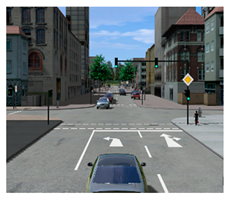 |
| S2: Navigating intersection with traffic light and driving straight on | 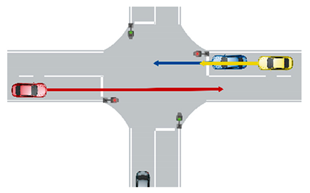 | 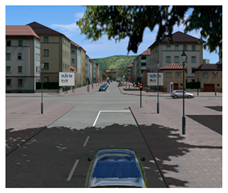 |
| S3: Cyclist ahead, turning left |  | 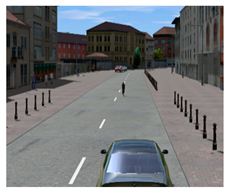 |
| S4: Passing static bottleneck due to roadworks | 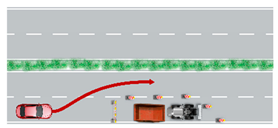 | 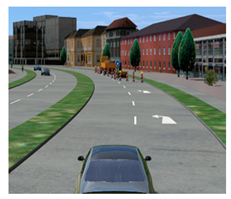 |
| S5: Passing a dynamic bottleneck due to a broken-down vehicle |  | 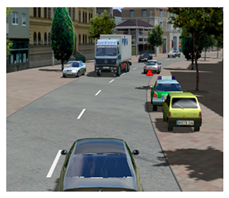 |
| S6: Following a vehicle in front | 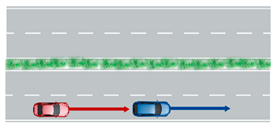 | 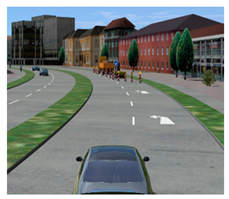 |
| S7: Speed reduction due to entering a 30 km/h zone |  |  |
| Between-Subject Factor | n | Instrument Cluster | Windshield |
|---|---|---|---|
| M (SD) | M (SD) | ||
| Experienced | 16 | 6.6% (4.0%) | 54.8% (29.0%) |
| Inexperienced | 24 | 6.2% (3.8%) | 53.6% (26.2%) |
| NRDA | 20 | 5.6% (4.0%) | 31.8% (18.2%) |
| No NDRA | 20 | 7.1% (3.6%) | 76.3% (11.0%) |
| Within-Subject Factor | N | Instrument Cluster | Windshield |
|---|---|---|---|
| M (SD) | M (SD) | ||
| Scenario 1 | 40 | 6.9% (4.4%) | 50.7% (28.7%) |
| Scenario 2 | 40 | 7.1% (4.8%) | 53.4% (28.8%) |
| Scenario 3 | 40 | 5.7% (4.8%) | 57.5% (27.0%) |
| Scenario 4 | 40 | 6.0% (4.4%) | 57.3% (28.9%) |
| Scenario 5 | 40 | 7.0% (5.6%) | 53.1% (26.9%) |
| Scenario 6 | 40 | 6.3% (5.0%) | 51.1% (27.3%) |
| Scenario 7 | 40 | 5.5% (4.4%) | 55.4% (30.0%) |
| Between-Subject Factor | n | System Status | Navigation Information | Current Speed | Speed Limit |
|---|---|---|---|---|---|
| Mdn | Mdn | Mdn | Mdn | ||
| Experienced | 16 | 6.00 | 4.75 | 3.50 | 2.00 |
| Inexperienced | 24 | 4.00 | 5.00 | 6.00 | 3.75 |
| NRDA | 20 | 5.25 | 4.25 | 4.25 | 3.00 |
| No NDRA | 20 | 4.00 | 5.50 | 5.75 | 4.25 |
| Within-Subject Factor | N | System Status | Navigation Information | Current Speed | Speed Limit |
|---|---|---|---|---|---|
| Mdn | Mdn | Mdn | Mdn | ||
| Scenario 1 | 40 | 6 | 6 | 4 | 3 |
| Scenario 2 | 40 | 5 | 5 | 5 | 4 |
| Scenario 3 | 40 | 5.5 | - | 5 | 3 |
| Scenario 4 | 40 | 5 | 4 | 5 | 4 |
| Scenario 5 | 40 | 5 | - | 4.5 | 3 |
| Scenario 6 | 40 | 5 | 5 | 5 | 4 |
© 2020 by the authors. Licensee MDPI, Basel, Switzerland. This article is an open access article distributed under the terms and conditions of the Creative Commons Attribution (CC BY) license (http://creativecommons.org/licenses/by/4.0/).
Share and Cite
Feierle, A.; Danner, S.; Steininger, S.; Bengler, K. Information Needs and Visual Attention during Urban, Highly Automated Driving—An Investigation of Potential Influencing Factors. Information 2020, 11, 62. https://doi.org/10.3390/info11020062
Feierle A, Danner S, Steininger S, Bengler K. Information Needs and Visual Attention during Urban, Highly Automated Driving—An Investigation of Potential Influencing Factors. Information. 2020; 11(2):62. https://doi.org/10.3390/info11020062
Chicago/Turabian StyleFeierle, Alexander, Simon Danner, Sarah Steininger, and Klaus Bengler. 2020. "Information Needs and Visual Attention during Urban, Highly Automated Driving—An Investigation of Potential Influencing Factors" Information 11, no. 2: 62. https://doi.org/10.3390/info11020062





